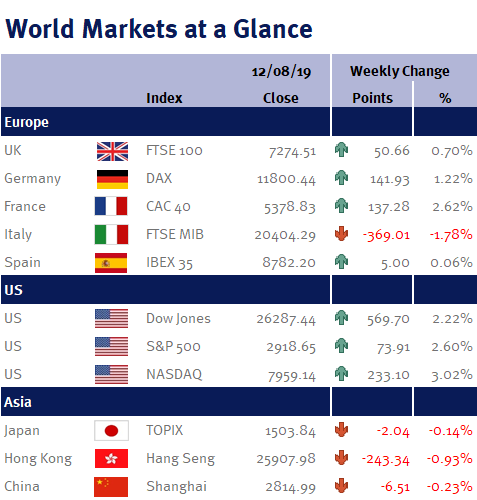In a week that seemed primed to be dominated by central bank meetings and policy, in particular by the US Federal Reserve (Fed), it ended up being hijacked by none other than US President Donald Trump!
Week ending 2nd August 2019.
5th August 2019

In a quiet few months for trade and several stalemates in trade negotiations with the Chinese, on Thursday Trump announced a surprise further 10% of tariffs on Chinese goods. These tariffs are due to come into play on 1st September with Trump stating that the tariffs could go “well beyond” 25%. The Chinese have since pledged counter measures, which the market awaits. This has all come after a set of two day trade negotiations between the two countries ended with little progress. So, what does this mean? We have seen this type of posturing before in order to put pressure on the Chinese to reach an agreement, and with the date for the tariffs to come into effect coming after the intended next set of trade talks in August, the current pull back in equity markets seems an overreaction and if anything, could represent a buying opportunity ahead of further trade talks. As we have seen at several points this year alone, the market can severely react to short term news, which allows for great investment opportunities!
Trade aside, this week has been littered with central bank meetings with all eyes centred on the Fed! Following the Fed Chairman, Jerome Powell’s accommodative stance in recent months, there was heavy expectation that he would cut the headline rate. Whilst there was mixed expectation on the level of the cut, the Wednesday meeting saw Powell announce a small cut of 0.25% which disappointed markets initially. However, following the cut Powell announced the potential for a further handful of ‘mini’ rate cuts. So, whilst we again saw an extreme short term market reaction to the level of Wednesday’s cut, once the market has digested the ramifications of a series of small cuts, this could be seen as a buoy for the US economy as Powell strives to pick inflation up to the 2% target. Again, the Fed’s approach seems sensible for the economy and whilst Donald Trump thought Powell was too ‘hawkish’ in his approach, it allows the Fed more room for manoeuvre going into 2020, which is ultimately better for both US and Global equity markets.
On Thursday we also saw the Bank of England hold rates at 0.75%. This came after a drop in sterling following the Fed policy meeting a day earlier. Bank of England Governor, Mark Carney, went on to reduce the bank’s 2019/20 growth forecast for the UK economy to 1.3% citing uncertainty surrounding Brexit as the protagonist, whilst also keeping the possibility for both an increase and cut in interest rates on the table. This stance suggests that the outcome of Brexit is not a foregone conclusion and that the bank remains accommodative and data dependent. Carney’s comments on Brexit uncertainty comes a day after UK Chancellor, Sajid Javid, pledged £2.1billion to prepare for a ‘no-deal’ Brexit… now, whilst this does seem quite an extreme measure, it seems likely that this was a move designed to show Brussels that the UK was prepared to leave the EU with no deal rather than a bad deal, strengthening the UK’s hand.
Elsewhere we saw the Bank of Japan (BoJ) hold interest rates unchanged at -0.1%. Echoing the dovish sentiments of many other global central banks recently, the head of the BoJ (Haruhiko Kuroda) went on to state that they will not hesitate to make policy adjustments if required. As such, the level of purchasing of Japanese Government Bonds and indeed Exchange Traded Funds by the BoJ are being continued.
There was a suite of economic data released with arguably the most significant being today’s release of US employment figures that saw the headline unemployment rate remain unchanged, whilst the participation rate increased, suggesting a tightening in the labour market. We also saw Chinese manufacturing data beat prior numbers and expectation, European unemployment remains steady at its decade low of 7.5%, and European GDP beat expectations coming in at 1.1% year-on-year.
So, whilst this week has suffered from short term reaction and misguided sentiment, this has created short term opportunities. This has come in the same week that I found out that Narendra Modi, Prime Minister of India, one of the most attractive regions from a long term investment opportunity stance, is joining Bear Grylls on an episode of ‘Man vs Wild’. This is something I would encourage you to watch, as it will likely give insight into the type of man that Modi is, his charisma and indeed enthusiasm for his country! (I believe the show is due to be aired in August… but don’t hold me to that!).
Jonathan Wiseman, Fund Manager
The latest market updates are brought to you by Investment Managers & Analysts at Wealth at Work Limited which is a member of the Wealth at Work group of companies.
Links to websites external to those of Wealth at Work Limited (also referred to here as 'we', 'us', 'our' 'ours') will usually contain some content that is not written by us and over which we have no authority and which we do not endorse. Any hyperlinks or references to third party websites are provided for your convenience only. Therefore please be aware that we do not accept responsibility for the content of any third party site(s) except content that is specifically attributed to us or our employees and where we are the authors of such content. Further, we accept no responsibility for any malicious codes (or their consequences) of external sites. Nor do we endorse any organisation or publication to which we link and make no representations about them.

